Analysis: The President's Patrons
Update 18 October: This post has been updated to reflect that additional information about Trump property patrons was made available in the print edition of the source article.
Last Saturday, the New York Times released a new chapter in its ongoing investigation of President Trump’s finances. The story, titled “Trump’s Swamp: Taxes Trace Payments to Properties by Those Who Got Ahead,” details how organizations with a direct financial interest in federal government policy have spent lavishly at Trump Organization properties since 2017.
The report’s 13-person byline and references to nearly 250 interviewees both hint at a blockbuster investigation of politically-motivated spending. An animated network diagram in the online articles adds to the sense of scale: as you scroll down, the diagram highlights hundreds of dots, each one representing an interest group who spent money at a Trump property.
Much of the narrative focuses on particular individuals and organizations who spent large amounts of money at Trump properties, then lobbied the president to adopt policies in their favor. While these stories are important and concerning, they describe only a small fraction of the parties covered by the investigation. Without descriptive statistics to characterize spending and influence across all interest groups, and with the background diagram only ever naming a few organizations at a time, it’s hard to determine how representative those narratives are across President Trump’s wider patronage network.
To understand the web of politically-motivated spending at Trump properties, anyone can pull the patronage dataset underlying the Times report’s web visualization. The dataset identifies new spenders and connections that were not reported in the Times online article. Anyone can analyze and visualize the data in ways that offer a broader perspective on interest group spending.
Understanding the dataset
The dataset underlying the scrolling visualization for “The Swamp That Trump Built,” is currently available to the public on the New York Times website. To see the raw data for yourself:
- Navigate to the article page
- Open the “Inspect Element” view on your browser
- Search the for a JSON object assigned to
window.ENTITIES
The data contains a total of 227 interest groups who patronized Trump properties since 2017. Each row, representing a different group or individual, is made up of nine columns:
okn(true/false): include name and label in the publicly-available dataset?key: Uniquely-identifying label for the visualization. Anonymized except for rows whereoknis true.nyt_label: Labels shown on the NYT website visualizationnyt_label_2: Subtitles shown on the NYT website visualizationisMember(true/false): Is the group or individual a member of a Trump Organization property?isBallardClient(true/false): Was the group a client of lobbyist Brian Ballard?paidFirstTwoYears(true/false): “The Swamp That Trump Built” describes 60 interest groups that spent $12 million at Trump Organization properties in 2017 and 2018, allegedly winning preferable government treatment. Is this individual or organization one of those 60 groups?type: Classification of the interest group:
| Interest group type | Count |
|---|---|
| Advocacy Group | 23 |
| Business | 99 |
| Charity | 10 |
| Foreign-biz | 2 |
| Foreign-gov | 15 |
| Foreign-other | 4 |
| Religious Org. | 19 |
| Trade Association | 49 |
| (Uncategorized) | 6 |
matched_property_id_1: The primary Trump property where a given group spent money. The report mentions that some organizations patronized more than one property, but only the primary location has been reported in the publicly-available dataset:
| Trump Property | Count |
|---|---|
| Trump International Hotel - Washington, D.C. | 104 |
| Mar-a-Lago | 69 |
| Trump National Doral - Miami | 40 |
| Trump National Golf Club - Bedminster | 6 |
| Trump National Golf Club - Washington, D.C. | 3 |
| Trump International Hotel & Tower - Chicago | 3 |
| Trump International Hotel - Las Vegas | 1 |
| Trump Turnberry - Scotland | 1 |
It is unclear whether this data represents all interest groups covered by the investigation, or just a subset. Note also that the amount of money spent by each group is not included in the data, although spending amounts from select organizations were highlighted alongside the print version of the story.
New findings
Distribution of interest groups across properties
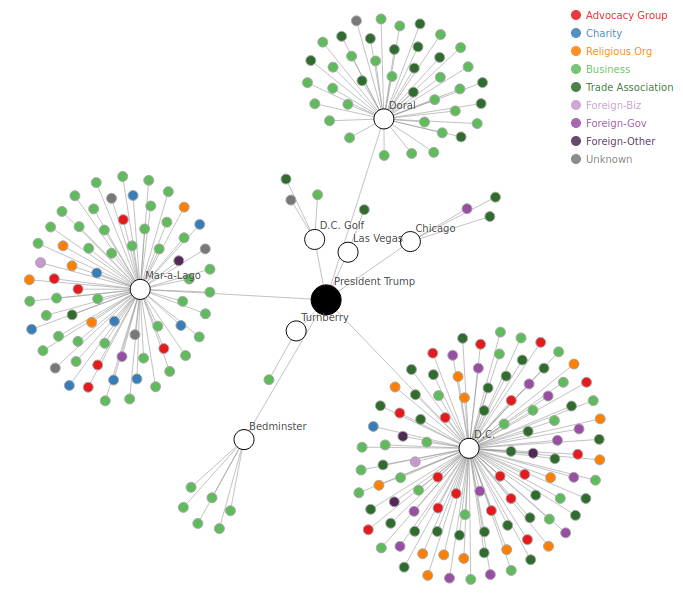 Visualizing the patron network by business type
Visualizing the patron network by business type
By color-coding interest groups by type, we can get a sense of the different communities that formed around each Trump property. [Update 18 Oct: Some of this information was reflected in a graphic accompanying the the print edition of the original article]
Businesses and trade associations make up the bulk of political spenders at the Trump golf clubs in Doral, Bedminster, Washington, D.C., and Turnberry. At Mar-a-Lago, business interests intermingled with advocacy groups and charities, although business groups were far more likely to buy memberships—all but three Mar-a-Lago members in this dataset were classified as businesses, with two of the remaining members being Trump’s chosen ambassadors to South Africa and the Dominican Republic. The Trump International Hotel in Washington, D.C. was home to a more motley crew of political spenders, including religious groups and representatives from at least 13 foreign governments.
Named patrons not previously reported
Of the 227 Trump organization patrons included in this dataset, only 48 were identified by name. This includes 12 named interest groups that were displayed in a graphic accompanying the print edition of the article, but not the online edition:
| Interest group name | Trump Property |
|---|---|
| Indian Government | D.C. Intl. Hotel |
| U.S. Chamber of Commerce | Doral |
| Center for Security Policy | Mar-a-Lago |
| Chirag Patel - Amneal Pharmaceuticals | Bedminster |
| Concerned Women for America (Unlabeled) | D.C. Intl. Hotel |
| Domestic Energy Producers Alliance | D.C. Intl. Hotel |
| First Liberty Institute | D.C. Intl. Hotel |
| Florida Police Chiefs Association | Doral |
| Heartland Institute | D.C. Intl. Hotel |
| Independent Petroleum Association of America | D.C. Intl. Hotel |
| Big Dog Ranch Rescue | Mar-a-Lago |
| Sovereign Nations | D.C. Intl. Hotel |
The two bolded groups were both listed among the 60 patrons who spent substantial amounts of money at Trump properties during 2017-2018. The Indian government’s inclusion on this list may partly stem from a period in February and March 2017 when Indian diplomats spent $18,650 at the Trump International Hotel in Washington, D.C. [Update 18 Oct: the print edition of the original article also listed the spending amount as $18,650]. For its part, the U.S. Chamber of Commerce hosted a three-day executive retreat at the Trump National Doral in March 2018.
The patronage dataset also provides new details about two groups briefly mentioned in the article. The “Polish business group” apparently refers to a 2018 session of the Polish-American Leadership Summit held by the Casimir Pulaski Foundation, a Polish think tank. The Trump Organization’s connection to the People’s Democratic Party of Nigeria appears to come through Atiku Abubakar, a Nigerian presidential candidate, as previously reported by ProPublica.
| Interest group name | Data identifier | Trump property |
|---|---|---|
| Polish business group | pulaski foundation polish american leadership summit | Mar-a-Lago |
| People’s Democratic Party of Nigeria | atiku abubakar peoples democratic party of nigeria | D.C. Intl. Hotel |
Identifying big spenders
The Times article makes a remarkable claim about a subset of Trump property patrons in this investigation:
Just 60 customers with interests at stake before the Trump administration brought his family business nearly $12 million during the first two years of his presidency, The Times found. Almost all saw their interests advanced, in some fashion, by Mr. Trump or his government.
The average amount of money spent by these 60 organizations—approximately $200,000 each—is believable given the other sums described in the article. What strikes me is the implication that the Times has matched spending from each of these customers to favorable treatment from the Trump administration. The untold stories of these 60 interest groups are a ripe subject for more detailed reporting as the investigation continues. [Update 18 Oct: the print edition of the article suggests that over 90% of all patron groups had their interests furthered by the Trump administration]
So who are these groups? While many of these organizations remain anonymous in the underlying dataset, we can get a sense for the types of groups that may have paid their way into the administration’s good graces:
| Type | Interest group name |
|---|---|
| Business | Bank of America |
| Business | David Storch, AAR Corp. |
| Business | Deloitte |
| Business | Embry-Riddle Aeronautical University |
| Business | George C. Zoley, GEO Group |
| Business | Jeffrey P. Feingold, MCNA |
| Business | Morgan Stanley |
| Business | (31 unnamed businesses) |
| Foreign-Gov | Indian Government |
| Foreign-Gov | (2 unnamed foreign governments) |
| Religious Org | Christian Broadcasting Network |
| Religious Org | Billy Graham Evangelist Association |
| Religious Org | Summit Ministries |
| Religious Org | (2 unnamed religious organizations) |
| Trade Association | National Automobile Dealers Association |
| Trade Association | National Shooting Sports Foundation |
| Trade Association | U.S. Chamber of Commerce |
| Trade Association | (10 unnamed trade associations) |
| Unknown | (1 unnamed and uncategorized organization) |
Businesses and trade associations dominate this subset, and a full 29 of the 60 highlighted groups patronized the Trump National Doral resort.
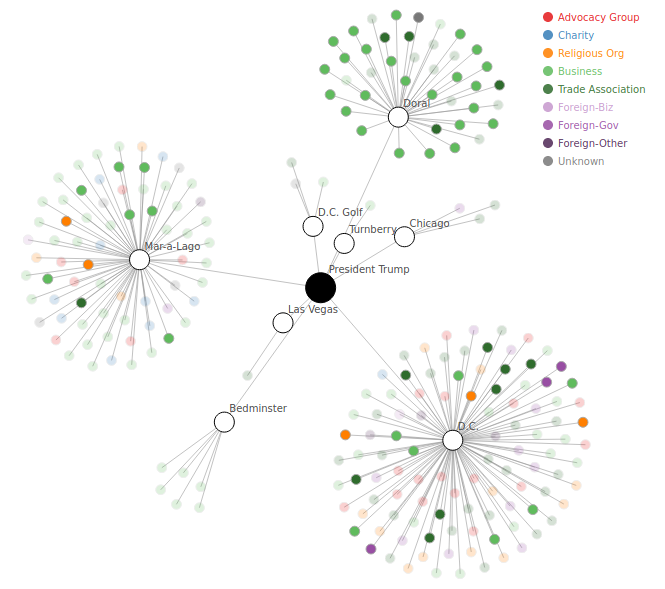 Sixty interest groups that spent a combined $12 million at Trump properties
during 2017 and 2018
Sixty interest groups that spent a combined $12 million at Trump properties
during 2017 and 2018
The three foreign governments in this group, including India and two unnamed countries, are not described in the Times article. Their inclusion in a cohort where “almost all saw their interests advanced” is unnerving—we deserve to know the identities of all three governments, how much money was spent, and how that spending may have influenced government policy.
Clients of Brian Ballard
The article describes how Brian Ballard, a Florida lobbyist and GOP donor, became “the most powerful lobbyist in Trump’s Washington” thanks partly to connections forged at Trump properties. Of the six clients listed in the article, four are named in the Times article:
- U.S. Sugar
- The private prison operator GEO Group, represented by founder George Zoley
- The Syrian-American activist group Citizens for a Secure and Safe America, led by Rim Al-Bezem
- The People’s Democratic Party of Nigeria, likely presidential candidate Atiku Abubakar
The Times reports that two additional Ballard clients spent money at Trump properties. While the underlying dataset does not include the names of these clients, it does provide some identifying information:
- An unnamed foreign entity, listed as neither a government nor a corporation, that patronized the Trump International Hotel in Washington, D.C.
- An unnamed advocacy group which also patronized Trump’s D.C. hotel
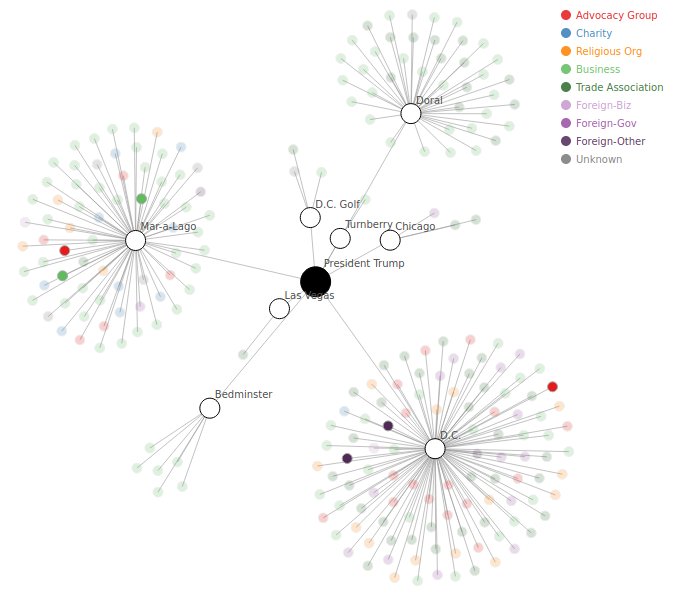 The six interest groups listed as clients of Brian Ballard
The six interest groups listed as clients of Brian Ballard
Visualization
I created an interactive visualization to explore all 227 patrons implicated in the Times article. The network structure is the same as in the original article, with money flowing from patrons to a primary Trump property, and with all of the Trump properties centered around the president.
Colors denote each interest group type. You can also focus attention on particular subsets of patrons: those identified by name, members of a Trump property, Brian Ballard clients, and the 60 big spenders highlighted by the Times.
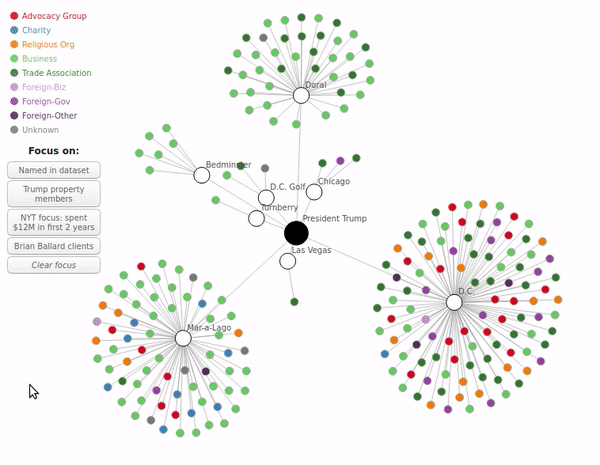 Switching focus between subsets of patron groups
Switching focus between subsets of patron groups
You can click on nodes to learn more about individual patrons and properties, or drag nodes to rearrange the chart.
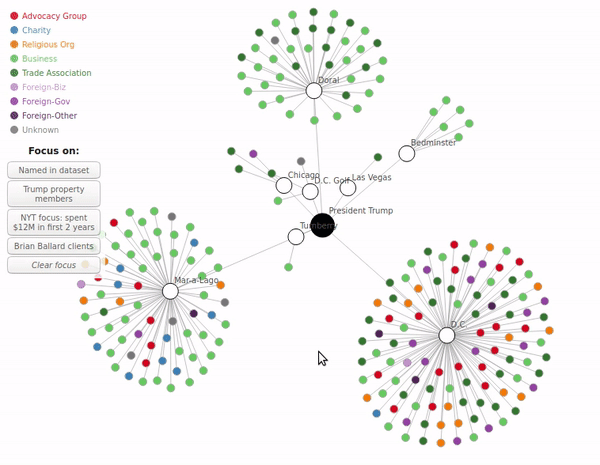 Dragging and highlighting nodes
Dragging and highlighting nodes
You can explore the visualization for yourself here.
We live in a crowded news cycle. The 1922 Teapot Dome affair involved substantially less money changing hands (equivalent to $7.2 million today) than the amounts detailed in the Times investigation. But while Teapot Dome is remembered as the biggest cabinet scandal before Watergate, the Times report has already disappeared from the headlines without creating much of a splash in public discourse.
Given the urgency of this report’s claims, my goal is to make the underlying data about Trump property patrons more accessible to a general audience. This analysis is still far from complete: nearly 80% of interest groups remain anonymous, their spending and influence comfortably hidden from the public eye. In light of the ongoing general election, we deserve a full accounting of this patronage network and its consequences for American government.
This is a secondary analysis of a dataset published by the New York Times in conjunction with Citizens for Responsibility and Ethics in Washington, Public Citizen, and the 1100 Pennsylvania newsletter. I do not have firsthand access to the records underlying this dataset, so I cannot confirm the veracity of any claims or report with certainty the meaning of data labels.
Have questions or comments? Let me know!
